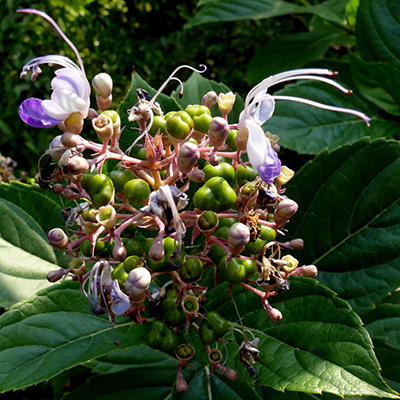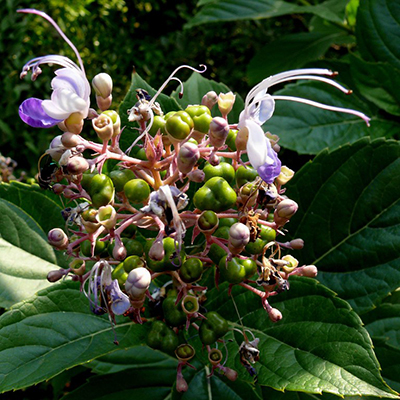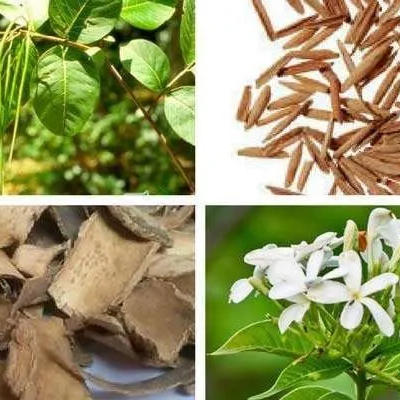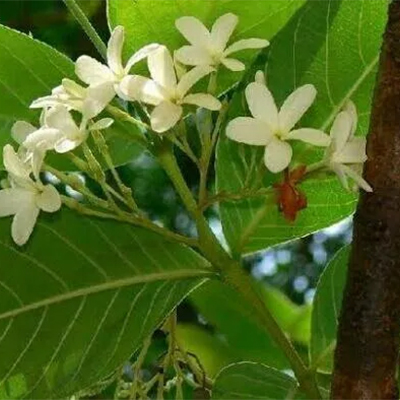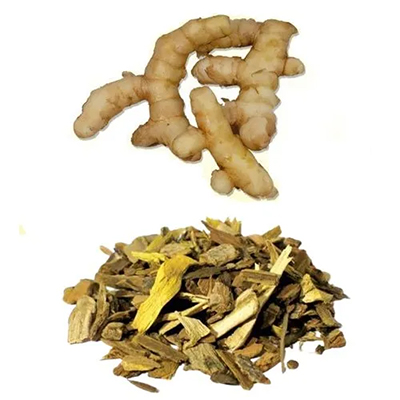On This Page
Bharangi: A potent anti-allergic drug
Introduction
In the Indian system of medicine, various herbs are used to treat respiratory disorders. Bharangi botanically known as Clerodendrum serratum is a plant of the Verbenaceae family that is one of the most important plants which is used to treat Shvasa Vaha Strotas Roga i.e Respiratory disorders. It is very famous with the name Glory bower. Bharangi is believed to possess the power of the sun and is therefore considered auspicious and believed to treat all disorders. Mainly the root part of Bharangi is used which is proved to be an excellent anti-inflammatory, expectorant, anti-allergic, carminative, mast cell stabilizer, sudorific, etc. Due to the above-given properties, Bharangi is used to treat tuberculosis, rhinitis, asthma, jaundice, worm infestation, etc.
Basonym of Bharangi
भञ्जति इति भारङ्गी। भृन्ज्जतित्य्के (नि आ) भनक्ति रोगान भर्गो अस्त्य अस्मात इति वा। भन्ज्जो आमर्दने।
Bharangi destroys all the diseases. it possesses the potency of the sun.
Synonyms of Bharangi
- According to morphology
खरशाक- खरंशाक: पत्रमस्या: ।
Leaves of Bharangi are rough.
पद्म- पद्माभं पुष्पमस्या: ।
The flowers are red like that of a lotus.
अंगार वल्ली-अंगारा भवल्ली अस्य इति अंगार वल्ली ।
When blossoms appear like Angara (red hot coal).
- According to properties and action
ब्राह्मणी- पवित्रत्वात् ब्राह्मणी इति ।
Bharangi is a very auspicious plant.
ब्राह्मणयष्टिका- ब्राह्मणस्ययष्टि रिव इति । तादृशप्रकाण्डत्वात् ।
The auspicious plant has a stem-like that of Yashti.
Regional names of Bharangi
- Glory bower, Beetle killer, Blue glory, Turk’s turban moon (English)
- Bambunhati (Bengali)
- Bharangi (Gujarati)
- Bharangi, Babhanaiti (Hindi)
- Gantu Bharangi (Kannada)
- Cherutekku (Malayalam)
- Bharangi (Marathi)
- Kavali (Tamil)
- Gantubharangi (Telugu)
Botanical Name
Clerodendrum serratum Linn.
Clerodendron – Clero means chance, because of the uncertainty of the medical properties. Dendron means shrub.
Serratum – Serratum is based on saw-toothed margins of the leaves.
Family
Verbenaceae (Nirgundi Kula)
Ayurveda reference for Bharangi (Clerodendrum serratum Linn.)

Scientific classification of Bharangi
| Kingdom | Plantae |
| Class | Dicotyledons |
| Subclass | Gamopetalae |
| Series | Bicarpellate |
| Order | Lamiales |
| Family | Verbenaceae |
| Genus | Clerodendrum |
| Species | serratum |
Classification of Bharangi as per Charaka and Sushruta
- Charaka: Pureesh Sangrahniya Mahakshaya
- Sushruta: Pipplyadi Varga
Bharangi’s description in Brihtrayi
| Charaka | Shusruta | Vagbhata
(Ashtang Hridya) |
| C. S. Su. 27/ 142 | S. S. Su. 38/ 15, 21 | A. H. Su. 15/ 28, 30, 33 |
| C. S. Vi. 8/ 158 | S. S. Su. 39/ 6 | A. H. Chi. 1/ 62 |
| C. S. Chi. 3/ 313 | S. S. Chi. 6/ 13 | A. H. Chi. 3/ 12, 14, 15, 62, 64, 95, 128, 159 |
| C. S. Chi. 6/ 42 | S. S. Chi. 12/ 5 | A. H. Chi. 4/ 24, 32, 44, 46 |
| C. S. Chi. 7/ 111 | S. S. Chi. 15/ 19 | A. H. Chi. 5/ 44, 51 |
| C. S. Chi. 8/ 171 | S. S. Chi. 17/ 44 | A. H. Chi. 6/ 40 |
| C. S. Chi. 10/ 20, 41, 44 | S. S. Chi. 18/ 5, 13, 40 | A. H. Chi. 8/ 49 |
| C. S. Chi. 11/ 36 | S. S. Chi. 37/ 12, 19, 36, 39 | A. H. Chi. 12/ 22, 25 |
| C. S. Chi. 16/ 120 | S. S. Ka. 5/ 69 | A. H. Chi. 14/ 14, 17, 120, 121 |
| C. S. Chi. 17/ 102, 109, 110 | S. S. Ka. 6/ 15 | A. H. Chi. 16/ 37 |
| C. S. Chi. 18/ 47, 51, 54, 58, 63, 112, 127, 158, 178 | S. S. U. 39/ 191, 195, 221 | A. H. Chi. 19/ 81 |
| C. S. Chi. 23/ 95 | S. S. U. 41/ 47 | A. H. Ka. 4/ 55, 63 |
| C. S. Chi. 26/ 153, 167, 283 | S. S. U. 47/ 36 | A. H. U. 2/ 10, 49, 51, 76 |
| C. S. Ka. 7/ 14 | S. S. U. 51/ 21, 23, 33, 38, 43 | A. H. U. 7/ 21 |
| C. S. Si. 4/ 3, 12 | S. S. U. 51/ 13, 20, 30, 33, 41 | A. H. U. 24/ 51 |
| S. S. U. 57/ 7, 10 | A. H. U. 37/ 84 | |
| S. S. U. 61/ 34, 38, 40 | A. H. U. 39/ 170 |
Bharangi’s description as the Padma in Brihtrayi
Charaka Samhita: C. S. Su. 4/ 31, C. S. Vi. 8/ 151, C. S. Ci. 1. 4/ 7, C. S. Chi. 3/ 257
Sushruta Samhita: S. S. Sa. 10/ 60, S. S. Chi. 2/ 73, 82, S. S. Chi. 11/ 9, S. S. U. 40/ 73, 74, 122
Vagbhata: A. H. Su. 15/ 37, A. H. Sa. 2/ 53
Bharangi’s description as Phanji in Brihtrayi
Charaka Samhita: C. S. Su. 27/ 96
Sushruta Samhita: S. S. Su. 38/ 14, 18, S. S. Su. 46/ 249, 252, S. S. Ka. 1/ 61, S. S. U. 40/ 113
Vagbhata: A. H. Chi. 9/ 24
Historical background of Bharangi
On review of the literature, it is observed that Bharangi is one of the most common herbs in the Ayurvedic formulation (classical) used in the treatment of respiratory disorders. However, the identity of the drug is still controversial. Though Brihattrayi texts and Nighantu writers have described one variety of Bharngi we come across two types in Vaidyaka Shabda Sindhu. They are Sveta Pushpa (white flowered) and Nila Pushpa (blue-flowered). Maybe this description is the source of controversy. The former is C. indicum while the latter variety is C. serratum Linn. respectively. Sometimes C. infortunatum Linn is also used as Bharangi by others.
Thakurji reported that the market samples are not from the above sources but are obtained from the bark of Elaeodendron glaucum Pers & Gardenia turgida Roxb. Even the root of Picrasma quassioides Benn. is also sold as Bharngi. Thakurji believes that the Padma described by Charaka under Purisha Sangrahaniya Mahakshaya is Bharngi (C. S. Su. 4/ 31). Chakrapani commented on the Padma as Brahmanayastka which is the synonym of Bharngi. Charaka mentioned Phanji also in the context of Anna Varga (C. S. Su. 27/ 96). Padma and Phanji are sometimes identified with Premna herbacea Roxb. Dr. Koppula Hemadri a renowned botanist of Andhra Pradesh (retired scientific officer, CCRAS, Vijayawada) informs that Pygmaeopremna herbacea Roxburgh as Bharangi (Gantu Bharangi in Telugu).
External Morphology
Two plants are generally considered to be the source of the drug Bharangi, and are provided here with detailed information-
External morphology of Clerodendrum serratum
- Habit- Bharangi is a shrub that grows up to 7 feet in height.
- Stem- Stems of Bharangi are bluntly quadrangular, young parts glabrous.
- Leaves- Leaves of Bharangi are opposite, big, up to 28 cm long but usually 12- 15 cm in length, 5.5- 6 cm wide, oblong or elliptic, acute, coarsely and sharply serrate, glabrous, petioles are very stout, 6 mm long.
- Inflorescence- The inflorescence of Bharangi is a panicle, 15-20 cm long.
- Flowers- Flowers of Bharangi are numerous, showy have a pair of acute bracts at each branching, pedicels twisted, and flowers are bluish to dark purple.
- Fruit- The fruit of Bharangi is a drupe, 6 mm long, somewhat succulent, broadly obovoid, and normally four-lobed.
Flowering and fruiting time
The flowering and fruiting time of Bharangi is between May and October.
External morphology of Pygmaeopremna herbacea
- Habit: Perennial herb with woody rootstock, often branched and running horizontally with ellipsoid or variously shaped knots of 1-1.5 cm thick.
- Stem: The stem of Bharangi is absent or up to a few centimeters high.
- Leaves: Leaves of Bharangi are simple, opposite – ternate, generally one set per plant, closely adpressed to the ground, sessile – subsessile, 5- 14 x 4-10 cm, obovate with pubescent nerves, and coarsely create – dentate margins in the upper half.
- Inflorescence: Inflorescence of Bharangi is terminal corymbose, 5-10 cm long panicle, flowers are very small, white with a tinge of yellow, calyx 0.2 cm long, cup-shaped and obscurely 2 – lipped, the upper 2 – lobed and the lower 3 – lobed, corolla about 0.4 cm long with a short tube, 2 – lipped and 5- lobed, stamens 2+2, ovary with linear style and bifid stigma.
- Fruit: Fruit of Bharangi is a globose drupe, about 0.6 cm in diameter, seated on the enlarged persistent calyx cup, seeds solitary.
- Flowering & Fruiting – November-February
- Distribution – Pygmaeopremna herbacea is found as undergrowth in the deciduous andmixed types of forests along the Eastern ghat belt and Central India including AndhraPradesh, Orissa, Chhattisgarh, and Madhya Pradesh. It grows gregariously in forest lands cleared by forest fires etc.
Distribution of Clerodendrum serratum
It is distributed throughout India, Ceylon, and the Malay Peninsula. Throughout the country ascending to 1524 meters altitude from sea level. It is found in Karnataka, Kerala and Tamil Nadu, and the Himalayan Terai region especially Nepal, Kumaon, Bengal, and Bihar, also in the southern region of India.
The useful part of Bharangi
Mula (Root).
Roots are hard, cylindrical, gradually tapering, 2 to 5 cm in diameter, split longitudinally into half, External surface is rough, dark brown, with scattered patches of small beady warts and circular scars. The centrally split pieces show a creamish yellow, longitudinally striated woody surface with a well-marked pith. The bark is up to 2 mm thick and is always accompanied by a substantial portion of the woody part of the root. The root is difficult to break and becomes fibrous. The root does not have any odor.
Important phytoconstituent of Clerodendron serratum
- Root- bark- Root bark of Bharangi contains D-mannitol, gamma -Sitosterol, Glucose, Stigmasterol, Traces of saponins, serratagenic acid, oleanolic acid, queretaro acid, and B-sitosterol.
- Leaves- Leaves of Bharangi yield alpha- spinasterol, Catechin, Luteolin, Apigenin, Baicalein, Scutellarein, Caffeic acid, Ferulic acid, Arabinose & glucuronic acid, Plantarenaloside, and euphrosine.
Recent research on Bharangi
- A new compound, serratin, was isolated from the essential oil of Clerodendron serratum along with lupeol. The structure of the compound has been elucidated based on chemical analysis and spectroscopic methods including IR, MS, and NMR techniques. Ravi Kumar, Lakshmanan AJ, Ravi S. Chemical constituents from Clerodendron serratum. J Asian Nat Prod Res. 2008 Jul Aug; 10 (7- 8): 659- 62.
- The ethanol extract of Clerodendron serratum roots and ursolic acid isolated from it were evaluated for hepatoprotective activity against carbon tetrachloride-induced toxicity in male Wistar strain rats. The results when compared with the standard drug silymarin revealed that the hepatoprotective activity of the constituents ursolic acid is significant as similar to the standard drug, Vidya SM, Krishna V, Manunatha BK, Mankani KL, Ahmed M, Singh SD. Evaluation of the hepatoprotective activity of Clerodendrum serratum L. Indian J Exp Biol. 2007 Jun; 45 (6): 538- 42.
- The alcoholic extract (50, 100, and 200 mg/kg, p. o.) of Clerodendron serratum roots produced significant antinociceptive, anti-inflammatory, and antipyretic activities in animal models. Narayanan N, Thirugnana- Samantha M P, Viswanathan S, Vijayasekaran, V Sukumar E. Antinociceptive, anti-inflammatory and antipyretic effects of ethanol extract of Clerodendron serratum roots in experimental animals. J Ethnopharmacology. 1999 Jun; 65 (3): 237-41.
Rasa Panchaka of Bharangi
| Rasa (Taste) | Katu (pungent), Tikata (bitter), Kashaya (astringent) |
| Guna (Virtue) | Laghu (light), Ruksha (dry) |
| Virya (potency) | Ushana (hot potency) |
| Vipaka (post-digestion) | Katu (pungent) |
Dosha Karma of Bharangi
Kapha- Vata Hara
Kapha Hara because of Katu Vipaka, Ushana Virya, and Katu, Tikat, Kashaya Rasa.
Vata Hara because of its Ushana Virya.
Karma (Actions) of Bharangi
Deepan, Pachana, Kasa Hara, Swasa Hara, Sotha Hara, Krimighana, Vrana Hara, Ruchi Kara, Arshoghana, Jwara Hara.
Prayogarha Vyadhi (Therapeutic indication) of Bharangi
- Swasha
- Kasa
- Aruchi
- Peenasa
- Agnimandya
- Gulma
- Sotha
- Jwara
- Rajayakshma
- Vrna
- Krimi
- Jwara
- Rakta Gulma
- Arsha
Aamyik Prayog (Therapeutic uses) of Bharangi
Swasha Roga (Bronchial asthma):
- Pastes of Bharangi and Sunthi or Marica and Yava Kshara should be taken with the decoction of Devadaru, Chitraka, Asphota, and Murva. (Charaka Samhita Chikitsa Sthana. 17/ 110)
- Bharangi should be taken with ghee and honey. (Shusruta Samhita Uttara Tantra. 51/ 39)
- One suffering from hiccough and asthma should take Bharangi mixed with Shuthi with hot water or Shunthi with sugar, Bharangi, and Sauvarchala. (Vrinda Madhava. 12/ 9)
Kasa (Cough): Ghee should be cooked with a paste of Bharangi in four times curd and double the quantity of Brihati decoction. It is an excellent remedy for Vataja Kasa. (Vanga Sena Kasa. 17)
Arsha (Piles): The same processing of buttermilk is done with Bharangi, Asphota, Yavani, Amalaka, and Guduchi (A jar is pasted inside with the root of Bharangi, and buttermilk is kept therein for a certain period and thereafter used in food and drinks). (Sushruta Samhita Chikitsa Sthana. 6/ 13)
Madatya (Alcoholism): Bath is taken with water boiled with Bharangi. (Sushruta Samhita Uttara Tantra. 47/ 36)
Galagandaadishu (Goiter etc.): Local application of the paste of Bharangi pounded with sour gruel alleviates goiter, cervical adenitis, and scrotal enlargement. (Chakra Dutta 41/ 24, Raja Amrittanda 17/ 1)
Vankshan Vaate (Inguinal hernia): Roots of Bharangi collected in the Pushya constellation are pounded with sour gruel. Its intake alleviates inguinal hernia. (Vanga Sena Vradhna. 8)
Shiro Gate Vishe (Poisoning): In case of poison located in the head, roots of Bandhuka, Bharangi, and black Tulsi should be used as snuff. (Charaka Samhita Chikitsa Sthana. 23/ 181)
Shastra Kshte (Accidental wound): Local application of the root of Bharangi pounded with water is useful in the accidental wound. (Gada Nigreha 4. 4. 56)
Benefits of Bharangi
- Respiratory disorders (Swasa Vaha Strotas Vyadhi): Bharangi along with an excellent broncho dilator act as a very good decongestant, due to which helps to minimize the attack of dyspnea. Along with this Bharangi with its mucolytic action oozes out extra mucus from the body. Bharangi also acts as an expectorant therefore useful in hoarseness of voice, cold, cough, and various other respiratory disorders.
- Skin disorders (Kustha Roga): Recent research revealed that Bharangi acts as an excellent blood purifier and therefore helps to treat various skin disorders like boils, and herpes even though it is a powerful remedy for erysipelas i.e Visarapa.
- Gastrointestinal disorders (Aamashya- Pakvashya Gata Vyadhi): Bharangi exhibits various actions like laxative activity, appetizer, etc due to which it is used in anorexia, constipation, a stomach infection, and hiccups, overall, we can say that it boosts the health of the Gastrointestinal Tract.
- Herpes simplex virus infection: Herpes simplex virus viral Sexually transmitted disease and cold sores in the mouth. These conditions are very painful. Bharangi with its anti-inflammatory properties eases the symptoms that appear in Herpes simplex virus infection.
- Allergy: Bharangi exhibits anti-histaminic action due to which it inhibits the physiological effect of histamines. Thus, helps to treat various kinds of allergies.
- A tumor (Granthi): Bharangi exhibits anti-tumor activity thus, inhibits the growth of the tumor.
- Wound healing (Vrana Ropana): Bharangi with its antiseptic, anti-inflammatory properties, etc helps to quickly heal the wounds, and ulcers and also helps in relieving the burning sensation.
Effect of Bharangi on different systems of bodies
- Digestive system: Being an appetizer, digestant, and laxative, it is useful in anorexia, loss of appetite, and Gulma. Seed rubbed in buttermilk is useful in ascites.
- Circulatory system: Raktagani, purifies blood, improves Agni of Rakta, and alleviates edema. It is therefore used in blood disorders like abscesses caused by Vata, Kapha, etc.
- Respiratory system: Since it is Snigdha and Madhur, it acts as an expectorant. It is therefore useful in coughing and hoarseness of voice. Raktagnii, Kapha Nashak property is also helpful in cold and tuberculosis. A mixture of Bharangi root juice and ginger juice is given for asthma to reduce the attacks of dyspnea.
- Reproductive system: In amenorrhoea, Bharangi powder is used along with the decoction of sesamum seeds.
- Skin: Diaphoretic.
- Temperature: Being an Ama digestant, and hot (diaphoretic), it is used in fever. Cooked vegetables of Bharangi leaves are given in malaria.

Have A Health Issue?
Consult Online
- Dr. Sahil Gupta (B.A.M.S., M.H.A.)
Ayurvedic Allergy Specialist
CEO & Founder of IAFA®
Classical reference of Bharangi
Bhava Prakasha Nighantu Guduchyadi Varga- 143
Synonyms
भारंगी भृगु भवा पद्मा फञ्चजी ब्राह्मणयष्टिका ।
ब्राह्मणय अंगार वल्ली च खरशाकश्च हनचिका।।
Bhava Prakasha Nighantu Haritakyadi Varga- 182- 183
Synonyms
भार्गी रुक्षा कटु स्तिक्ता रुच्योष्णा पाचनी लघु: ।
दीपनी तुवरा गुल्म रक्तनुन्नाशयेद ध्रुवम् ।।
शोथकासकफ श्वास पीनस ज्वर मारुतान् ।।
Dhanwantri Nighantu Guduchyadi Varga, 68
भारंगी स्यात् स्वरसे तिक्ता चोष्णा श्वास कफापहा ।
गुल्मज्वरासृग वातघनि यक्ष्माणां हन्ति पीनसम्।।
Kaiydeva Nighantu Aushadi Varga, 1135- 1136
भारंगी तिक्ता कषायोष्णा दीपनी पाचनी लघु:।
कटवी रुक्षा ज्वर श्वास कास शोफ कफ अनिलान।
पीनस अरुचि गुल्म अस्त्र यक्ष्मा्ण विनियच्छयति।
Raja Nighantu Pipplyadi Varga- 151
भारंगी तु कटु तिक्तोष्णा कासश्वासविनाशनी ।
शोफ व्रण कृमिघ्नी च दाहज्वर निवारिणी ।।
Priya Nighantu, Shatpushpadi Varga, 126
भारंगी रुक्ष कटूष्णतिक्ततुवरा संदीपनी पाचनी,
वातश्लेष्महरी हरत्यतितरां श्वासमयं कष्टदम् ।
कासं पीनसमप्यपैति पवनस्रोत: सु रोधं द्रत शोथं हन्ति च रक्तगुल्ममखिल प्राणप्रदा ब्राह्मणी ।।
Charaka Samhita Chikitsa Sthana. 10/ 110
श्वास
भार्गीनागरयो: कल्क मरिच क्षारयोस्तथा।
पीतद्रु चित्रकास्फोतामूर्वाणां चाम्बुना पिबेत।।
Shustuta Samhita Uttara Tantra. 51/ 39
लिह्यात् भारंगी वा सर्पी मधु समायुताम।
Vrinda Madhava. 12/ 9
नागर वा सिता भारंगी सौवर्चलसमन्वितम्।।
Vanga Sena. Kasa. 17
कासे
भार्गीकल्कै: घृतज्चाथ पचेद् दध्नि चतुर्गुणे ।
भार्गीरसं द्विगुणितं वात कासहरं परम्।।
Shusruta Samhita Chikitsa Sthana. 6/ 13
अर्शसि
एष एव भार्ग्यास्फोतायवान्यामलक गुडूचीषु तक्रकल्प: ।
Shusruta Samhita Uttara Tantra. 47/ 36
मदात्यये
भारंगी शृतेन च जलेन हितो अवसेकः ।
Chakra Dutta. 41/ 24
गलगण्डादिषु
गलगण्ड गण्डमालां कुरण्डांश्च विनाशयेत्।
पिष्टम ज्येष्ठाम्बुना मूल लेपाद ब्राह्मणयष्टिजम।।
Raja Amrittanda. 17/ 1
संपेषित ब्राह्मणयष्टिकाया: मूलं सम तण्डलधावनेन।
निहन्ति लेपादथ गलगण्डमाला कुरण्डमुख्यानखिलान् विकारान्।।
Vanga Sena Vradhana. 8
वंक्षण वात
पुष्योद्धृत हरेदाशु घानाद् वंक्षण वातजित।
भार्गी मूल खण्डन्तु पानाद वंक्षण वात जित।।
Charaka Samhita Chikitsa Sthana. 23/ 181
शिरोगते विषे
शिरोगते विषे नस्त: कुर्यान मूलानि बुद्धिमान।
बन्धुजीवस्य भार्गयाश्च सुरसस्यासितस्य च।।
Gada Nigreha. 4. 4. 56
शस्त्रक्षते
भार्गीणां मध्यत: प्रलेपेन ।
एकस्या: जलपिष्टं मूलं शस्त्रक्षतेषु हितम्।।
Specific Formulation of Bharangi
- Bharangi Churna for Shool and Agni Marda.
- Bharangyadi Lehya for Swasha
- Bharangyadi Kwatha for Kaphaja Jwara
- Bharangyadi Sura for Unmada
- Dhanwantri Ghrita for Prameha
- Vidangadi Churna for Mandagni
- Bharangi Guda
- Vasa Avleha
- Ayaskriti
- PushkarMool Aasava
- Amrit Prasha Ghrita
- Khadiradi Gutika
Contraindication and side effects
Bharangi when taken in the advised dosage does not cause any side effects or adverse effects. It is recommended to avoid the use of Bharangi during pregnancy and Lactating mother or if necessary, they must be used under medical supervision.
Suggestive reading regarding Bharangi
- Gaurav, Arun & Mhase, Archana & Nirawane, Rekha & Kolhe, Rasika & Penchala Prasad, Goli & Mangal, Anupam & Srikanth, Narayanam. (2020). Multiplication of Bharangi—Clerodendrum serratum (L.) Moon: An Ayurvedic Important Plant. Journal of Drug Research in Ayurvedic Sciences. 4. 10.5005/ jdras-10059-0078.
- Vijay R, Shukla J, Saxena R. In vitro effect of various plant growth promoters on Clerodendrum serratum. Int J Pure App Biosci 2016;4(6):186–192. DOI: 10.18782/2320-7051.2409.
- Singh, Mukesh & Khare, G. & Iyer, S.K. & Sharwan, G. & Tripathi, D.K.. (2012). Clerodendrum serratum: A clinical approach. Journal of Applied Pharmaceutical Science. 2. 11-15.
- Upadhyay S, Koche V. Comparison of different mediums and establishment of an efficient micropropagation technique of Clerodendrum serratum L. an endangered medicinal plant. Journal of Environmental Science, Toxicology and Food Technology 2015;1(1):27–35
- Hazekamp A., Verpoorte R. Isolation of a Bronchodilator Flavonoids from the Thai Medicinal Plant Clerodendrum Petasites. J Ethnopharmacology. 2001; 78: 45-49.
- Narayanan N., Thirugnanasambantham P., Viswanathan S., Vijayasekaran V., Sukumar E. Antinociceptive, Anti-inflammatory and Antipyretic Effects of Ethanol Extract of Clerodendrum serratum Roots in Experimental Animals. J Ethnopharmacology. 1999; 65: 237-241.
- CHOUDHARI, D. D., & KULKARNI, Y. (2019). A critical review on bharangi [clerodendrum serratum (Linn.) Moon] with special reference to Ayurvedic Nighantus (lexicons). Ayurlog: National Journal of Research in Ayurved Science, 7(07). Retrieved from https://www.ayurlog.com/index.php/ayurlog/article/view/440
- Gupta A, Prajapati PK. Effect of different Avaleha in the management of Tamaka Shwasa (Bronchial Asthma). Journal of AYU 2011; 32(3):427-31. Cited on 25.9.2014 http://www.ncbi.nlm.nih.gov/pmc/articles/PMC3326896/
- Bhangare Nk, Pansare TA, Ghongane BB, Nesari TM. Screening for anti-inflammatory and anti-allergic activity of Bharangi {Clerodendrum serratum (Linn.) Moon} in animals. International Journal of Pharma and Bio Sciences 2012; 3(4):245–254. Cited on 5.9.2014 http://www.ijpbs.net/vol-3/issue-4/Pharma/29.pdf 16. Shareef MI, Leelavathi S, Gopinath S, Shareef M.
- Evaluation of in-vivo Activity of Clerodendrum serratum L. against Rheumatism. International Journal of Innovative Research in Science, Engineering, and Technology 2013; 2(12):7750-58. Cited on 23.9.2014 http://www.ijirset.com/upload/2013/december/53A_Evalu ation.pdf
References
- Agnivesha, Charaka, Dridhabala. In: Charaka Samhita, ed. Vaidya Jadavaji Trikamji Aacharya., editor. Varanasi: Chaukhamba Sanskrit Sansthan; 2009.
- Sushruta. In: Sushruta Samhita, Sutra Sthana, ed. Vaidya Jadavji Trikamji Acharya., editor. Varanasi: Choukhambha Orientalia; 2005.
- Vagbhata. In: Ashtanga Hrudaya, 9th ed. Anna Moreshwar Kunte, Krishnashastri Navarre, Harishastri, editors. Varanasi: Choukhambha Orientalia; 2005.
- Bhavamishra. In: Bhava Prakasha Nighantu, Haritkyadi Varga, Guduchyadi varga 11th ed. part 2. Brahma Shankara Mishra., editor. Varanasi: Choukhambha Bharati Academy; 2009.
- Bhavprakasha, commentary by Bulusu Sitaram, forwarded by K.C.Chunekar
- Sharma PV, Kaideva Nighantu. Aushadhi Varga. Chaukhamba Orientalia, Varanasi; 2006:
- Tripathi I., Raja Nighantu, Pipplyadi Varga, Chaukhamba Krishnadas Academy; Varanasi; 2010
- Dhanwantri Nighantu, Guduchyadi Varga
- P.V. Sharma, Priya Nighantu, Shatpushpadi Varga, Chaukhamba Krishnadas Academy; Varanasi.
- Dr. Gyanendra Pandey, Dravyaguna Vigyana, reprint 2012, Chawkhamba Krishnadas Academy
- K. Niteshwar Dravyaguna Vigyan, reprint 2017.
- Dr. J.L.N. Sastry and Dr. B.S. Sastry, Dravyaguna Vigyana, Chaukhambha Orientalia, Varanasi.
- Chakrapanidatta, Chakradatta with the vaidaya Prabha hindi commentary by indra deva tripathi, chaukambha sankrita sansthan, varanasi 2nd Edition, 1994.
Ayurveda is an Indian system of medicine that is popular since ancient times. Dr. Gupta’s IAFA® has been conducting research studies to find out different phytoconstituents of herbs and their action in the body. Such knowledge acquired by our experts is used in the preparation of medicines and providing the treatment facilities safely and effectively. IAFA® is the provider of safe and effective treatment for a wide range of diseases, mainly allergic diseases all based on Ayurveda.

